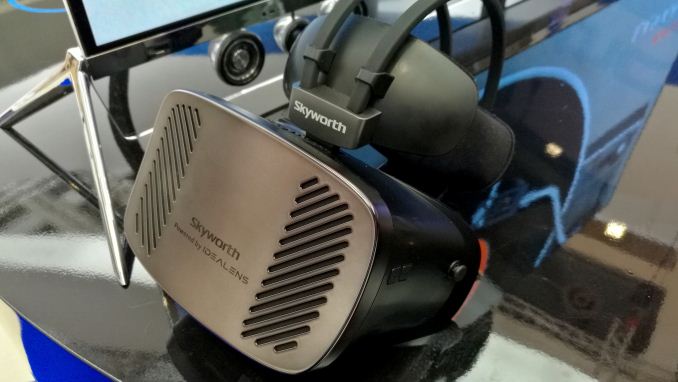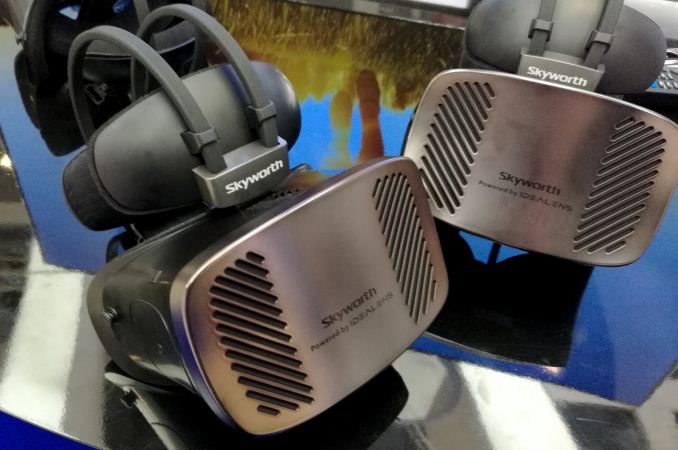IFA 2016: Examining the Malaise of Bargain Basement Virtual Reality
by Dr. Ian Cutress on September 9, 2016 9:00 AM ESTGoing Above $100: The Skyworth AIO-VR
In the last few minutes of the show I was steered towards the Skyworth booth in a different hall and told to go see their all-in-one headset. I was told that in comparison to the others, the Skyworth offering might be a substantial substitute above the cheap VR on display. The problem is always the cost, which we’ll get onto in a minute. The Skyworth VR setup was on display to test, however there were no specifications on display, and we weren’t allowed to take a picture of the image on the demonstrator’s phone that had all the hardware listed, but I was able to memorize a few key points.
It’s worth saying that the Skyworth AIO-VR was slightly bulkier than the other headsets, if only because the mechanism to mount it on your head was a plastic part of the design, aimed at balancing the weight a little but also securing it more firmly with padded guards. The outside was still plastic, however with a brushed metal look, and slightly more attention to detail.
The units were up and powered, and after putting it on I could tell the interface was smooth. Don’t get me wrong, the pixels were still quite obvious, but moving my head showed a high frame rate display better than the 30/60 Hz offerings of the cheaper implementations.
As far as I could jot down in a reasonable time, the headset uses an Exynos 7420, which is a 4x4 big.Little design using quad ARM Cortex A57 at 2.1 GHz and quad ARM Cortex A53 cores at 1.5 GHz on a 14nm process. The 7420 also uses Mali-T760MP8 graphics, at 772 MHz, which is good for 210 GFLOPs, and is paired with dual-channel (2x32-bit) LPDDR4. This SoC was powering dual 1080x1200 displays inside, which is a formidable number of pixels, and I saw that we’re looking at a 3800 mAh battery. Other specifications I can’t remember, though one would assume a 4GB/64GB arrangement for memory and storage if this was a smartphone.
So here’s the thing: the Skyworth headset is essentially a smartphone under the hood that you can’t take out. So what makes it better than a Samsung VR headset where the smartphone can be attached / detatched? One would assume it’s a price thing, and we were told the price for the headset could be $400 to $800. I remarked that it was a pretty large range, but was told that the Skyworth headset is still a work in progress, with exact specifications to be decided later. If it was $400, it might be more palatable, but for $800 then it might be easier to go the smartphone route.
The Problem with Low Cost VR
This brings us around to the problem with VR right now. Everyone wants in on the bandwagon, and in a keynote at the event it was pointed out that in order for triple-A style games and film studios to start making content in these new formats, there needs to be more potential sales out there. Current estimates put 500k headsets in the market (of varying degrees of power) with another 2.7 million by the end of 2017. No game studio or film studio, working on the next FPS or Avatar, will make a massive piece of content for only 3.2 million people – it needs to be in the hands of tens of millions to even start to make sense, and we won’t be at that point for a number of years.
All that being said, you have a choice – investing in a premium VR headset to be able to experience the best will cost $700+, in terms of the headset itself plus any extra hardware you need to power it. The easiest way to enter the VR space with some clout is the smartphone or all-in-one route, but that is still a hefty cost. Then there is a large, long gap to the segment of very basic all-in-one virtual reality headsets as shown at IFA this year.
For $100, or the rough price of the Samsung headset without any internal hardware, you get a basic quad-core Rockchip design with limited functionality. I’m half inclined to suggest that a bucket be provided as well, just in case nausea takes over. But it shows what a state VR is in, when the hardware is still so expensive. In order to get a base experience that can truly be called VR, such as with the Skyworth headset, it might be as much as a high-end smartphone anyway. For mass market adoption, the cost to enter has to be low, but not so low we’re scraping the barrel for basic frame rates.
Picture Galleries















































59 Comments
View All Comments
Mugur - Monday, September 12, 2016 - link
IFA 2016? It's in the title...rahulsolanki1818 - Monday, September 12, 2016 - link
virtual reality is an awesome technology , it has improved the way of watching videos.Shadowmaster625 - Monday, September 12, 2016 - link
2.7 million by the end of 2017? At that rate it is going to be 5 years before we see a true killer app for VR. It is going to take a Nintendo-level innovation to actually speed this up.StrangerGuy - Tuesday, September 13, 2016 - link
Given how absolutely tiny the VR market is, I will go as far as to say any VR solution without a first party killer app will be an automatic market failure (like the writeup mentioned, good luck with the chicken and egg problem as a pure HW or SW VR vendor). That only leaves the current gen consoles and Apple with any chance of mainstream success at VR.Nenad - Monday, September 12, 2016 - link
I have GearVR, and I can see advantages of why this can be better than Samsung GearVR - and it is not the price. Basically, this would be "always ready" for use, unlike GearVR where you need to unlock, dock, then undock and unlock again (common GearVR bug that asks to 'unlock' already unlocked phone), then optionally clean phone display etc...
Often I had idea to use GearVR for some short gaming or 3D movie, and decided against due to this 'preparation' time. It is same reason as why I never used my PC for movie watching on TV, even if streaming works - too much time in preparations (set secondary display, change TV source...). It is amazing how important it is for things to "just work" with push of a button, without any complex preparation needed, if people are to use that thing frequently.
mebalzer - Monday, September 12, 2016 - link
As some who develops both hardware and software for VR and Mixed Reality, I appreciate great articles like this to confirm my own findings. Frankly buy a one of the Chinese Snapdragon 820/821 phones from LeTV, OnePlus3. Xiaomi, ZTE, or ZUK or the new Nexus/Pixel that will be Google Daydream compatible with an HMD shell and call it a day. Trying to push more than 60 fps on a mobile platform is hard if you want more than simple shaders and geometry and frankly anymore than that strapped to your head makes no sense. I would rather see more HMD designs like the Pico NEO which tethers the processor/battery/control and keeps the headset light.I can't say a lot right now, but a dual component design that I feel will afford you the ability to use a more powerful SOC (one we haven't seen in a phone), improved (light and comfortable) HMD design, display panel and optics, IMU, positional tracking and a power source without making the thing look the monstrosities from from Intel & AMD is really the only the course one can go at this time if you want to compete with the HTC Vive or even the Sony Playstation VR.
Sadly, getting it to a price point that doesn't make someone have second thoughts that they should have went with a dedicated system is the real challenge and frankly we are not there yet.
By the way, a little sneak peek at my NEODiVR uPLAy http://neodivr.com/images/NEODiVR-uPLAy-280.gif
cptnjarhead - Thursday, September 15, 2016 - link
I have the G7 edge with gearVR. I absolutely love it! Oculus store is great, and the content grows all the time. One of the best apps is the Netflix app. End space (not a rail shooter) is a really fun game, coupled with a Bluetooth controller you really get a great space flight experience. Affected the manor, well my daughter watches scary movies all the time without flinching, and she only lasted 2 minutes with affected, she threw the whole headset off. Sure the graphics are not Vive, or rift, but the whole system works like a console. easy menus and setup. Thats why i feel sony will have the best VR for the money. Content, cost and ease of use will be the winner. If successful, that will push more development to PC and other platforms and in a few years, the current high end VR platforms will seem archaic.serendip - Thursday, September 22, 2016 - link
I just got a VR Box unit as seen in the first image. It's like a fancier Google Cardboard device, with two lenses and a smartphone holder. Surprisingly it's not bad, I use it with a Xiaomi Redmi Note 3 and the resolution is decent. My favorite app so far is a solar system flythrough - the planets look huge hanging in 3D space, although the phone gets burning hot after 10 minutes of play. Movies don't look good on this because the pixels are visible.kompanions - Friday, May 1, 2020 - link
Virtual Reality is one of the trending buzzwords of the last couple of years, and yet many people say it still has a way to go until it "catches".